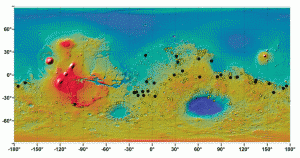Fire and water didn’t mix when it came to resurfacing basins that lie along Martian fluvial valley networks. A study of some 30 open-basin lakes (paleolakes) with floors covered by lava flows has concluded that at least these basins were dry by the time lava flowed into them and buried their lakebeds. The implication is that water activity in their associated valleys had shut down before lava flows covered the basin floors.

DRY HOLES. Black circles indicate 30 open-basin paleolakes whose floors have been resurfaced by lava flows with no sign of interaction between the molten lava and water. (Image taken from Figure 1 in the paper.)
The work was done by a team of scientists led by Timothy Goudge (Brown University); their report was published in the Journal of Geophysical Research. The researchers were studying the history of open-basin lakes and the Martian water cycle during a period when Mars scientists have thought that fluvial activity and volcanic resurfacing partly overlapped in time.
Open-basin lakes are usually large impact craters with both a water-eroded valley coming in and one leading out. At some point in their history, such basins would have held lakes (paleolakes). The 30 paleolake basins studied were selected from more than 200 because they were both volcanically resurfaced and large enough for dating using crater-counts.
About half of the 30 basins fall along the highland-lowland boundary, and Gusev Crater, where Mars Exploration Rover Spirit landed, was among the basins examined.
The scientists’ approach was to identify paleolakes whose floors showed volcanic landforms (or materials), then look for signs of lava interacting with water, and finally use counts of craters to determine an age for the lava resurfacing.
The team used orbital data and images (TES, THEMIS, CTX, HiRISE, HRSC) to identify lava flows, surface properties, and other volcanic details, as well as counts of craters (CTX, HRSC, and THEMIS). Remote-sensing instruments (CRISM, OMEGA) indicated mineral compositions.
When lava meets water, the team explains, certain identifiable geological features occur. These include lava deltas at shorelines, explosively formed cones along shorelines, rootless cones that form on wet sediments, tuyas (eruptions under glacier ice), and maar craters (formed when magma meets groundwater which explodes into steam).
None were seen. Says the team, “All of these features should have been resolvable with the resolution of images used, suggesting that they never formed in these locations, or if so, were buried by later lava flooding.”
As for ages, they report, “From the analysis of crater counts for the 30 basins…the resurfacing of the open-basin lakes occurred over a wide range in Martian history.”
Resurfacing began approximately 3.8 billion years ago, the team says, when the Noachian era changed to the Hesperian, and continued until around 2.9 billion years ago (Early Amazonian time). The majority of basins appear to have been resurfaced during the Hesperian, a period when volcanic flows resurfaced about 30 percent of Mars.
Although the date for the end of valley network activity appears to have overlapped with lava activity, the team concludes that “the volcanic resurfacing of these specific paleolake basins was not contemporaneous with the fluvial activity that carved the inlet and outlet valley networks and filled the basins with water.”
They add, “There must have been some period of desiccation at these sites subsequent to the end of valley network activity but prior to volcanic resurfacing.”








